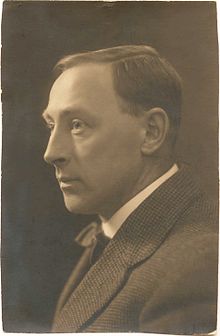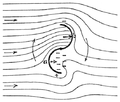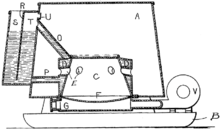Sigurd Savonius
Sigurd Johannes Savonius (born November 2, 1884 in Hämeenlinna , Finland ; † May 31, 1931 ) was a Finnish architect and inventor. He is particularly known for the Savonius rotor named after him , which he invented in 1924.
life and work
Sigurd was next to Maximilian Lars Helge and Odert Albin one of three sons of the couple Anna Elisabeth Rydman (1859-1921) and Albin Laurentius Johannes Savonius (1856-1906).
As a young man he experimented with explosives . Trying to mix red phosphorus with a knife and fork, he went blind in his right eye and lost two fingers.
Savonius graduated from high school in Helsinki in 1901. Contrary to his original plans to become an engineer, he embarked on a career in architecture and graduated in 1906 with a degree in architecture from the Helsinki Polytechnic. Nevertheless, he mostly described himself as an engineer and dealt intensively with technical constructions. In the same year his father died.
He met his future wife, the Englishwoman Mary Appleyard (* 1884), through his brothers. They took English lessons from her.
Together with his wife he had four daughters, Moira Angela Hjördis (* 1914), Ann-Mari, Mary Henrietta and Gustava Elisabeth as well as three sons Klas Albin, Mark Adrian Briggs and Johannes Anthony (* December 6, 1916). Anthony died in hospital on March 8, 1940 from an injury from the Winter War .
The family home was in Inkoo Bränseludden. Savonius had designed it himself.
On October 8, 1920 Sigurd founded "Savonius & Company" and his wife became a partner in the company.
Seven years after he graduated, his inventions resulted in a patent for a snow melting device for extracting drinking water from snow. In 1921 he presented an optimized version of this. In the same year he invented a stove for rock fireplaces. In addition, his mother died that year.
In the early 1920s, Savonius focused particularly on controlling air currents and harnessing wind energy. In 1923 a rotor ship built by the German Anton Flettner caught his attention. The ship was propelled by two tall, vertical masts, motor-driven, closed cylinders rotating faster than the wind speed, and the resulting Magnus effect . Savonius speculated whether the ship could also be propelled with pure wind power by a rotor system working with a similar effect without a motor-driven rotation aid.
He met with Flettner on the premises of his company Savonius & Company in Helsinki Lönnrotinkatu 20. Both experimented there together.
In early 1924 he finally developed a rotor in which the cylinder was open to the flow. Two blades offset against one another now caused a self-rotation with a very high torque that can also be used directly for energy generation. Whether it was actually possible for him to sail a ship primarily through the Magnus Effect, as originally intended, has not been proven. In a short Finnish biography, however, it is indicated that a corresponding application could well be conceivable, should it be technically implemented to be able to change the direction of rotation of the rotor during operation. This indicates possible successful results of his investigations of the rotor for suitability as a ship propulsion system. Dragons in Savonius shape make use of the functional principle and show that the Magnus effect is basically present in this rotor.
This invention for the use of wind energy was patented in Finland in 1926 and subsequently in many other countries. In the German patenting process, the authorities gave the as yet nameless invention the name Savonius rotor, under which it is known to this day. In the same year he published his book "The wing-rotor in theory and practice."
In addition to the rotor named after him, Savonius also submitted patents for an autonomously speed-regulating wind turbine and other inventions.
In 1931 Savonius invented a ventilation system based on his rotor. His interest in wind currents was his undoing in the same year. He chilled in the wind tunnel he'd built on his company's premises. He succumbed to the resulting pneumonia in the same year at the age of 46 on the last day of May. His brother Odert then took over the company and expanded its range. The patent for the ventilation system was bought by Anton Flettner's company Flettner Ventilator Limited, which still sells it today as a Flettner fan.
Patents filed by Savonius
- "Apparatus for melting snow and the like", US Patent 1125732, January 19, 1915 (pdf)
- "Snow Melter Apparatus / Appareil A Fondre La Neige", Canadian Patent CA000000196319A, January 20, 1920
- "Apparatus for melting snow and the like", US Patent US000001339719A, May 11, 1920
- "Anordning för åstadkommande av konstgjort drag på snösmältare utan användning av bläster", Finnish patent FI000000008437A, April 1, 1921
- "Kakelugnsinsats", Finnish patent FI000000008502A, June 22, 1921
- "Bränslebriquett eller stycke jämte härför avsedd ugn eller kamin, applicable även för solves bränsle", Finnish patent FI000000008501A, June 22, 1921
- "Kokapparat för hällspisar", Finnish patent FI000000008500A, June 22, 1921
- "Cheminée ou poele pour combustion centrale", French patent FR000000528762A, November 18, 1921
- "Förbränningsanordning", Finnish patent FI000000009093A, July 18, 1922
- "Machine à fondre la neige", French patent FR000000592249A, July 29, 1925
- "ΣΤΡΟΒΙΛΛΟΣ", Greek patent GR250100998, August 14, 1925
- "Snow melting machine", Austrian patent AT000000102020B, December 10, 1925
- "Rotor", French patent FR000000601266A, February 26, 1926
- "Rotor", Finnish patent FI000000011121A, April 10, 1926
- "Rotor", Austrian patent AT000000103819B, July 26, 1926
- "Improvements in or relating to wind rotors for producing rotary power and generating cross drive", British Patent GB000000244414A, September 9, 1926
- "Improvements in or relating to wind rotors", British Patent GB000000264219A, January 13, 1927
- "Rotor eller rotende Drivanordning", Danish patent DK000000037015C, January 17, 1927
- "Schneeschmelzvorrichtung", German patent DE000000452742A, November 21, 1927
- "Rotor / Rotor", Canadian Patent CA000000278888A, March 27, 1928
- "Windrad", German patent DE000000462462A, July 17, 1928
- "Improvements in or relating to wind rotors", British Patent GB000000299634A, November 1, 1928
- "Rotor adapted to be driven by wind or flowing water", US Patent US000001697574A, January 1, 1929
- "Reklamanordning", Finnish patent FI000000012540A, July 19, 1929
- "Wind turbine with two hollow blades, the inner edges of which reveal a central wind passage gap and overlap", German patent DE000000495518A, April 14, 1930
- "Wind rotor", U.S. Patent US000001766765A, June 24, 1930
- "Arrangement for light signs, showcases or the like", German patent DE000000512187A, November 10, 1930
- "Device driven by air flow for ventilation of closed spaces or for improving or maintaining a chimney draft.", Swiss patent CH000000147730A, June 30, 1931
literature
- The wing-rotor in theory and practice . (Reprint of the edition) Helsingfors, 1926. (Omnia-Mikrofilm-Technik, Munich, approx. 1981) (pdf; 11.80 MB)
Web links
- Short biography with a portrait ( memento from January 5, 2009 in the Internet Archive ) (Finnish)
- Short biography (Finnish)
- Johannes Tiusanen: Salaojakastelu tuulivoimalla . Helsinki 2002 (Finnish work on Savonius rotors for driving irrigation, contains images on pages 12 and 16 from Savonius' original work The wing-rotor in theory and practice )
- Various posters with different images from Savonius' life (pdf; 4.65 MB, Finnish)
Individual evidence
- ↑ Sigurd Savonius: Apparatus for melting snow and the like , US Patent 1125732, January 19, 1915 (pdf)
- ^ Sigurd Savonius: Apparatus for melting snow and the like , US Patent 1339719, May 11, 1920 (pdf)
- ↑ Sigurd Savonius: Kokapparat för hällspisar , Finnish patent FI000000008500A, June 22, 1921
- ↑ RUOHOLAHTI - SAARISTOIDYLLISTÄ OSAKSI TEOLLISTUVAA HELSINKIÄ ( Memento from January 5, 2009 in the Internet Archive )
- ↑ http://www.cit.gu.edu.au/~anthony/kites/rotor/types.html
- ↑ Sigurd Savonius: Rotor adapted to be driven by wind or flowing water , US Patent 1697574, filed August 13, 1925 (pdf) .
- ↑ Sigurd Savonius: Wind Rotor , US Patent 1766765, October 11, 1928 (pdf) .
- ↑ Sigurd Savonius: Arrangement for light signs, showcases or the like , German patent DE000000512187A, January 17, 1929 (pdf) .
- ↑ Sigurd Savonius: Device driven by air flow for ventilation of enclosed spaces or for improvement, resp. Preservation of a chimney draft, Swiss patent CH000000147730A, December 11, 1930 (pdf) .
- ↑ Sigurd Savonius Device driven by air flow for ventilation of closed rooms or for improvement, resp. Preservation of a chimney draft. , Swiss patent CH000000147730A, June 30, 1931
| personal data | |
|---|---|
| SURNAME | Savonius, Sigurd |
| ALTERNATIVE NAMES | Savonius, Sigurd Johannes |
| BRIEF DESCRIPTION | Finnish architect and inventor |
| DATE OF BIRTH | November 2, 1884 |
| PLACE OF BIRTH | Hämeenlinna , Finland |
| DATE OF DEATH | May 31, 1931 |






